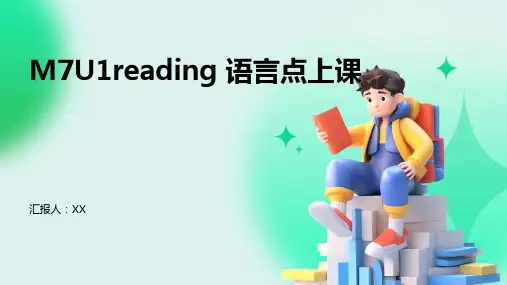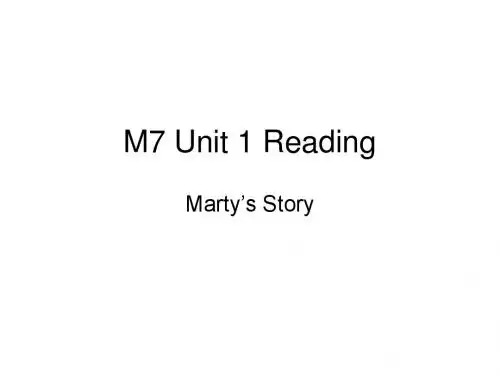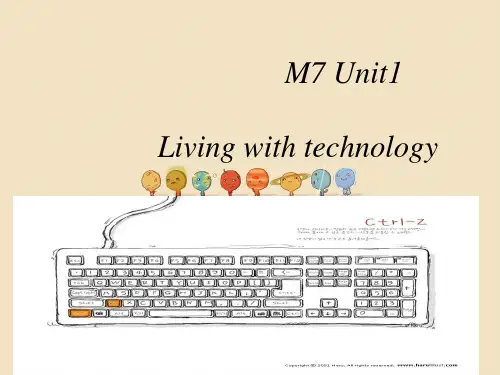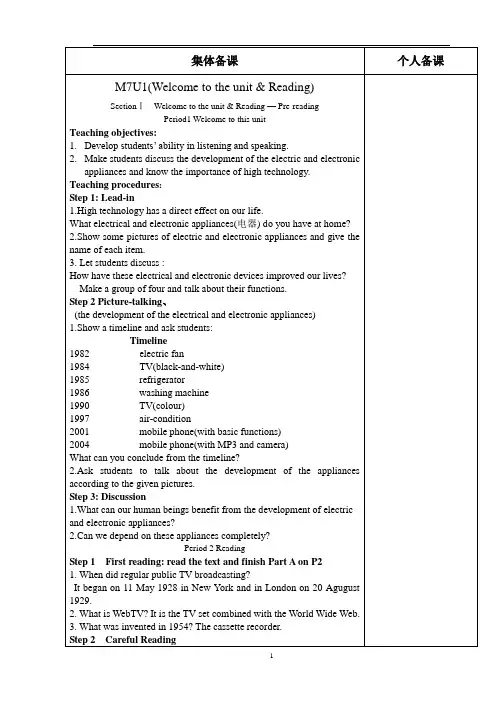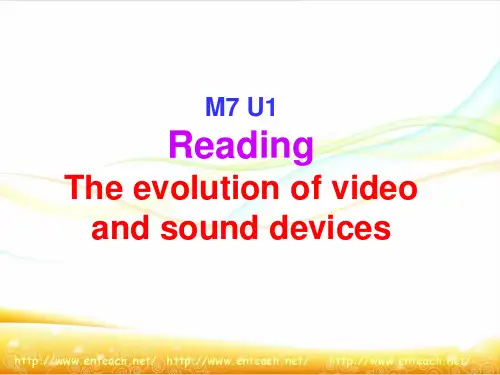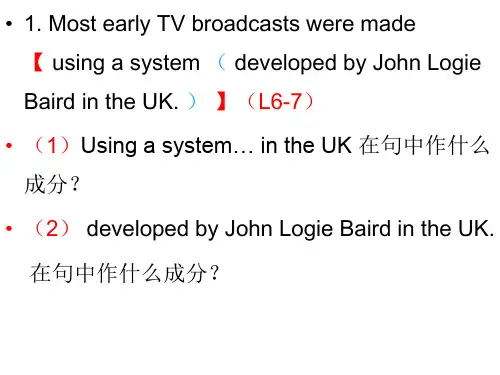M7U1reading
- 格式:pptx
- 大小:1.02 MB
- 文档页数:15
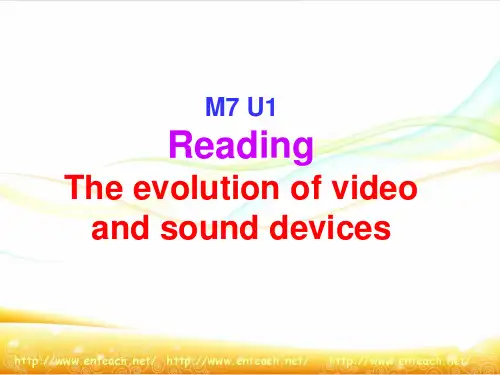
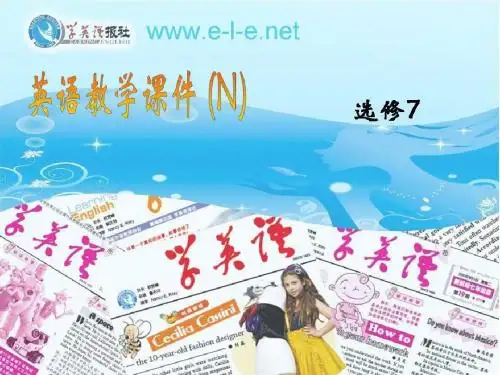
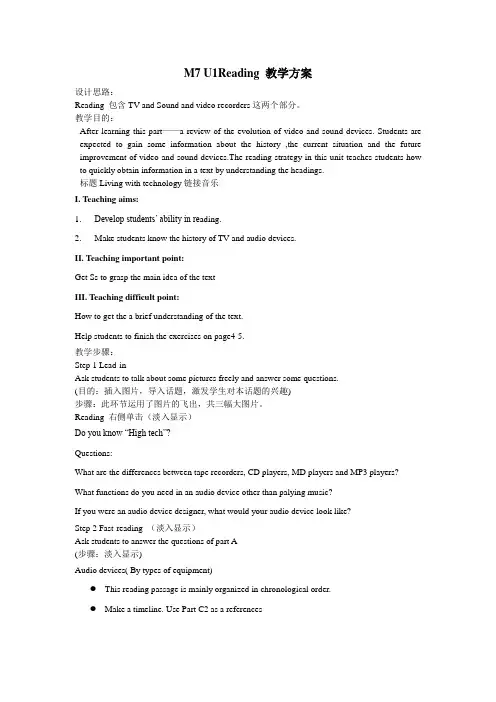
M7 U1Reading 教学方案设计思路:Reading 包含TV and Sound and video recorders这两个部分。
教学目的:After learning this part——a review of the evolution of video and sound devices. Students are expected to gain some information about the history ,the current situation and the future improvement of video and sound devices.The reading strategy in this unit teaches students how to quickly obtain information in a text by understanding the headings.标题Living with technology链接音乐I. Teaching aims:1. Develop students’ ability in re ading.2. Make students know the history of TV and audio devices.II. Teaching important point:Get Ss to grasp the main idea of the textIII. Teaching difficult point:How to get the a brief understanding of the text.Help students to finish the exercises on page4-5.教学步骤:Step 1 Lead-inAsk students to talk about some pictures freely and answer some questions.(目的:插入图片,导入话题,激发学生对本话题的兴趣)步骤:此环节运用了图片的飞出,共三幅大图片。
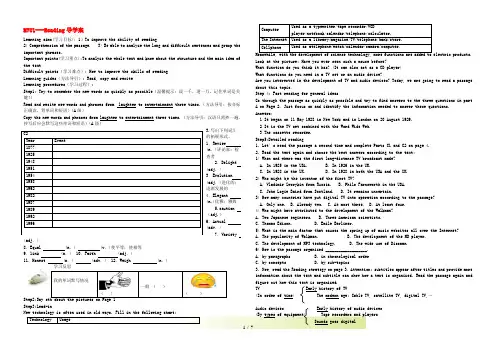
M7U1---Reading导学案Learning aims(学习目标):1)To improve the ability of reading2) Comprehension of the passage. 3) Be able to analyze the long and difficult sentences and grasp theimportant phrases.Important points(学习重点):To analyze the whole text and know about the structure and the main idea ofthe textDifficult points(学习难点): How to improve the skills of readingLearning guides(方法导引): Read, copy and reciteLearning procedures(学习过程):Step1: Try to remember the new words as quickly as possible(温馨提示:说一千,道一万,记住单词是关键!)Read and recite new words and phrases from laughter to entertainment three times.(方法导引:按音标正确读,背单词和短语)(A级)Copy the new words and phrases from laughter to entertainment three times.(方法导引:汉语只需抄一遍,抄写后应会默写这些单词和短语)(A级)3.写出下列词汇的拓展形式。
1.Review(n.)评论家;检查者2.Delight(adj.)3.Evolution(adj.)进化的;逐渐发展的4.Elegant(n.)优雅;雅致5.caution(adj.)6.Actual(adv.)7.Variety (adj.)8.Equal (n.) (v.)使平等;使相等9.1ink (n.) 10.Faith (adj.)11.Honest (n.) (adv.) 12.Weigh (n.)学习反思我的单词默写情况()一般()()Step2:Say sth about the pictures on Page 1Step3:Lead-inNew technology is often used in old ways. Fill in the following chart: Technology UsageComputerUsed as a typewriter/tape recorder/VCDplayer/notebook/calendar/telephone/calculator.The Internet Used as a library/magazine/TV/telephone/bank/store.Cellphone Used as atelephone/watch/calendar/camera/computer.Meanwhile, with the development of science technology, more functions are added to electric products. Look at the picture: Have you ever seen such a mouse before?What function do you think it has? (It can also act as a CD player)What functions do you need in a TV set or an audio device?Are you interested in the development of TV and audio devices? Today, we are going to read a passage about this topic.Step 4: Fast reading for general ideasGo through the passage as quickly as possible and try to find answers to the three questions in part A on Page 2. Just focus on and identify the information needed to answer these questions. Answers:1 It began on 11 May 1928 in New York and in London on 20 August 1929.2 It is the TV set combined with the Word Wide Web.3 The cassette recorder.Step5:Detailed reading1、Let’s read the passage a second time and complete Parts C1 and C2 on page 4.2、Read the text again and choose the best answers according to the text:1) When and where was the first long-distance TV broadcast made?A. In 1925 in the USA.B. In 1926 in the UK.C. In 1928 in the UK.D. In 1928 in both the USA and the UK.2) Who might b e the inventor of the first TV?A. Vladimir Zworykin from Russia.B. Philo Farnsworth in the USA.C. John Logie Baird from Scotland.D. It remains uncertain.3) How many countries have put digital TV into operation according to the passage?A. Only one.B. Already two.C. At most three.D. At least four.4) Who might have attributed to the development of the Walkman?A. Two Japanese engineers.B. Three American scientists.C. Thomas Edison.D. Emile Berliner.5) What is the main factor that causes the spring up of music websites all over the Internet?A. The popularity of Walkman.B. The develo pment of the MD player.C. The development of MP3 technology.D. The wide use of Discman.6) How is the passage organized ___________________.A. by paragraphsB. in chronological orderC. by conceptsD. by sub-topics3、Now, read the Reading strategy on page 3. Attention: subtitles appear after titles and provide more information about the text and subtitle can show how a text is organized. Read the passage again and figure out how this text is organized.TV Early history of TV(In order of time) The modern age: Cable TV, satellite TV, digital TV,…Audio devices Early history of audio devices(By types of equipment) Tape recorders and playersSounds goes digitalC2Year Event1877192519481951195419581962198219871989199219961 / 7Which of the following best shows the structure of the passage?A. TB. TC. TD. T(T =title ①= subtitle 1 ②= subtitle 2 ③= subtitle 3 ④= subtitle 4 ⑤= subtitle 5 )4、Now we can see that the reading passage is mainly organized in chronological order. A timeline ora time chart may help you understand the text better. Could you make a timeline by yourselves? Step 6: Practice:1. Besides the reading strategy, I’d like to give you another tip on reading. Do not refer to the dictionary every time you come across a new word. Ju st guess the meaning from the context. It is very important to read the sentences before and after the sentence which contains the unknown word. From the information before and after, you should be able to guess the meaning of the word. Now let’s complete Part D on page 4.2. Wang Li attended a media technology exhibition and after that he gives a report to his classmates about it. Read it in Part E and fill in the blanks with words given in the box.3、Read the text again and again. Try to memorize the language points.Parts A1 and A2 on pages106 & 107 in Workbook.Step 7: Homework:Read the text again and again. Try to memorize the language points.Parts A1 and A2 on pages106 & 107 in Workbook.Step 8:Deal with the language points(方法导引:Study the explanations of the language points, read and write the example sentences, and then do the exercises that follow.) (C级)知识精析:1、record n. 记录;成绩;唱片 v. 记录,记载;录音,录象recorder n. 录音机record player 电唱机 recording n. 录音,录音制品a school record学业成绩 break/beat the record破记录set (up) the record创记录 keep/hold the record 保持记录keep a record of sth把……记录下来make a record制作唱片The police keep record of all the traffic accidents.(改错)She (保持着世界记录) for the 100 meters.You should (记录) how much you spend.I’m fond of listening to r of famous singers ,such as CoCo Lee’s and Sun Yanzi’s.She took her Sony tape r out of her bag and placed it down.It all began in 1877 when Thomas Edison made the first r of a human voice.Information records, for example, of patients with the same illness, on computer now.A. are madeB. are sentC. are keptD. are set2、 contribute (…)to 捐献……贡献……给……有助于,促成投稿contributor撰稿人,捐款人contribution n.贡献,捐款All the children their free time the concert.所有的孩子把空余时间花听音乐会上了. Plenty of fresh air good health.充足的新鲜空气有助于健康His carelessness contributed to the accident.他的粗心大意是造成事故的原因.3、It is certa in/uncertain that (不)确定(certain/uncertain不能用sure/unsure替换)Sb be uncertain(sure) about/of…对……没把握Be sure/certain to do uncertainly adv.拿不准地 uncertainty n. 忧郁; 拿不准的事.We’re both what to do. 我们俩都不确定该怎么办.I’m (不确定他会不会赢) in the round.It’s what his role in the company will be, and he is a bit anxious about it at the moment. A. certain B. uncertain C. sure D. unsureThey smiled at one another.A. uncertainB. uncertaintyC. uncertainlyD. in uncertain terms4、 be superior to意为“优于……;胜过;比……好;”。
